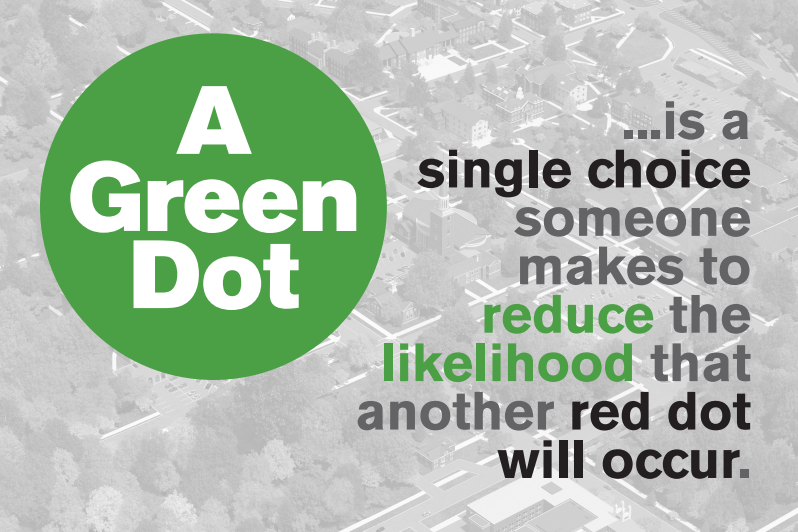Program Overview
What is Power-Based Personal Violence?
Power-based personal violence is a form of violence that has a primary motivator: assertion of power, control, and/or intimidation in order to harm another. Examples include dating/domestic violence, sexual assault, and stalking.
The Green Dot Bystander Intervention Program aims to prevent violence through the help of bystanders. Reducing the number of those on our campus who experience power-based personal violence can really happen. Our campus really can become safer. While no one has to do everything, if each of us does one or two or seven green dots, soon our maps will begin to change from red to green.
At Albion:
- Violence will not be tolerated
- Everyone is expected to do their part in maintaining a safe campus community
What is a Red Dot?
A Red Dot is a single choice someone makes to use their words or behaviors to hurt someone else.

Red Dot Examples:
- One red dot is forcing sexual or physical contact as part of hazing or initiation
- One red dot is the single choice to have sex with someone without consent
- One red dot is when someone uses their words to humiliate or threaten someone
- Red dots are the small choices someone makes to show up, unwanted, outside someone’s work, class, or car
What is a Green Dot?
A Green Dot is a single choice someone makes to reduce the likelihood that another red dot will occur.
A green dot does not have to be a BIG thing. We can reduce power-based personal violence on our campus by spreading reactive green dots. In fact, the only way this violence will be reduced is when the green dots begin to outnumber and displace the red dots.

Green Dot Examples
- A green dot is someone’s choice to check on a friend or classmate they are worried about. “Hey, I’ve been worried about you since you have been in this new relationship. I just want you to know I am here for you.”
- A green dot is when someone chooses to pull someone aside and check in when they see a situation that makes them uncomfortable. “Come to the bathroom with me. Are you okay? You seem like you’ve had a lot to drink and I am worried about you going home with someone.”
- A green dot is giving someone a ride home, telling someone to back off, calling the police, sharing your concern with a RA, or letting the bartender know there might be something high risk going on.
- A green dot is spilling a drink or asking for directions or starting a conversation to diffuse a situation that is escalating.
What is a Bystander?
A bystander is a person who is present at an event or incident but not involved. Green Dot educates students and employees to intervene as a violence prevention program by becoming active (proactive and reactive) bystanders.
Barriers
We’re good people who want to do the right thing, yet there is often something that keeps us silent, even when our gut is telling us to do something; these are called “barriers.” The three main types of barriers are listed below:
Personal:
- Introverted
- Fearful
- Uncertain
- Don’t want to be embarrassed
- Not sure if the situation is high risk, etc.
Relationship:
- Don’t want friends, family, or colleagues to be upset
- Don’t want to be a squeaky wheel or perceived as a “snitch” or “party police”
- Don’t want to break an unspoken code in my group or unit
- Pressure to go along, etc.
General:
- There are a lot of other people around, they’ll take care of it
- Afraid of being embarrassed or making a scene if you do something wrong
- If no one else is concerned about it, it’s probably not a big deal
How to Help – The Three D’s of Bystander Intervention
When you see a concerning behavior, use the Three D’s to help you think about a way you can help intervene. The most important thing is that you think of green dots that feel realistic in your life. If you’re running into one of your barriers (see above), the 3 D’s offer you different options to allow you to do something.
Direct
Intervene directly with the people involved.
Examples:
- Ask someone to stop what they are doing
- Check on someone you might be worried about
Delegate
Pull in someone else who may be in a better position to help.
Examples:
- Ask a person’s friends to help
- Talk to a trusted RA, Coach, Faculty or Staff member
- Tell the bartender to check in
- Leave an anonymous note for the team captain or Greek advisor
- Call Campus Safety 517-629-1234 or 517-629-0911
Distract
Create a diversion to diffuse or deescalate the situation without putting yourself in harm’s way.
Examples:
- “Accidentally” spill a drink
- Ask to borrow the phone of someone in a risky situation
- Start an unrelated conversation
- Say you’re feeling sick and you need the person being harmed to help you in the bathroom
Types of Green Dots
The Research Says…
The core elements of Green Dot programs are informed by rigorous research and evaluation. Green Dot has been implemented across the US Air Force, other branches of the military, colleges/universities, high schools, communities, organizations, and internationally.
In a 5-year longitudinal study, Green Dot was shown to reduce violence perpetration by up to 50% in Kentucky high schools. Other studies found a 17% reduction in colleges.
See more information regarding the progress the Green Dot program!
Albion Green Dot Statistics
- Students Trained: 89
- Employees Training: 38
- Green Dots Submitted: *Coming Soon*